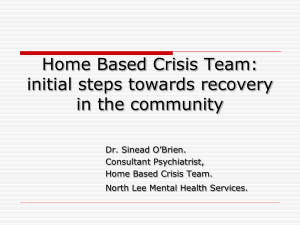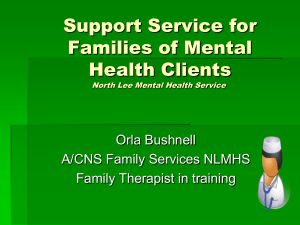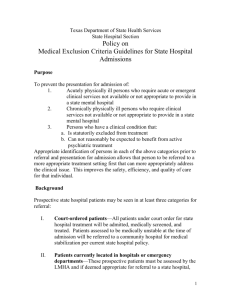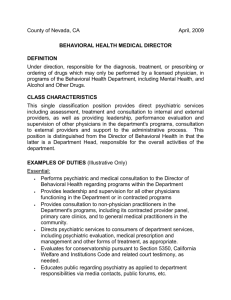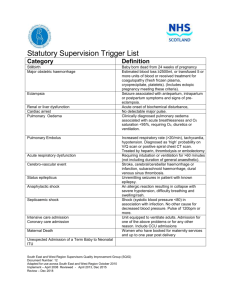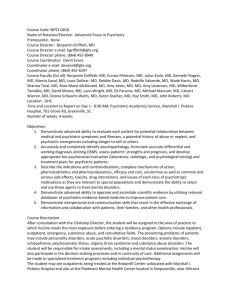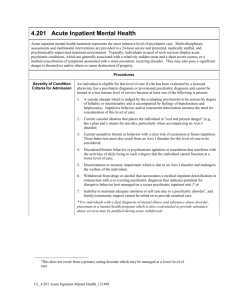setupHBCTposter
advertisement
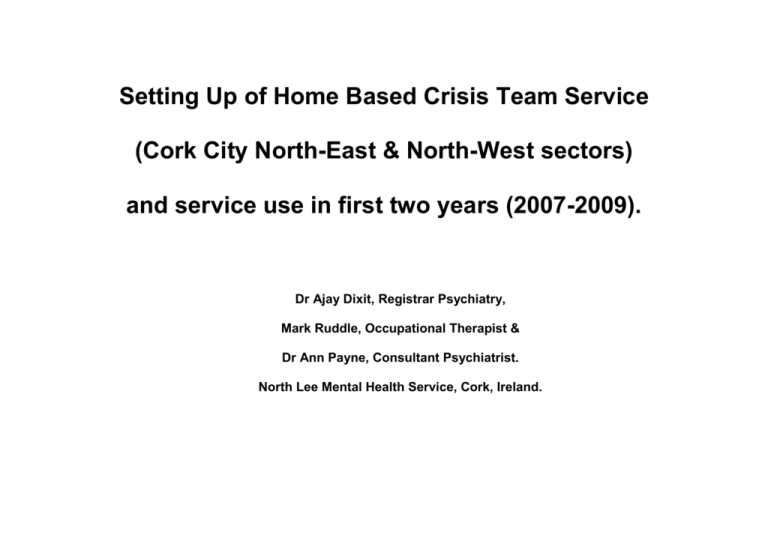
Setting Up of Home Based Crisis Team Service (Cork City North-East & North-West sectors) and service use in first two years (2007-2009). Dr Ajay Dixit, Registrar Psychiatry, Mark Ruddle, Occupational Therapist & Dr Ann Payne, Consultant Psychiatrist. North Lee Mental Health Service, Cork, Ireland. Background: In the last two decades home-based treatment for the mentally ill has become well established in the USA, the UK, Australia & recently in Ireland, (Cavan-Monaghan, Clondalkin (Dublin), North Kildare). (Gibbons & Cocoman, 2006). Most of the services are based on a crisis intervention model, with an acute home-care team providing care for a time-limited period, after which ongoing care is arranged with the general community mental health team. Trials in England have shown that the introduction of crisis resolution/home treatment teams, has been associated with a decrease in admission rates. (Johnson et al, 2005 & Glover et al, 2006). This poster examines the experience of setting up the Home-Based Crisis Team (HBCT) and its service use in the first two years. A pilot study was undertaken before setting up a crisis resolution team, which suggested that the Cork city northwest and north-east sectors (catering for ~56,000 population with a high index of social deprivation) accounted for ~55-60% of acute psychiatric admissions in North Lee (705 in the year 2006). If a crisis resolution team had been available, then potentially ~25% of crisis admissions could have been prevented. Original aims Provide a quality Multi-Disciplinary-Team (MDT) service to individuals in their homes as an alternative to admission. Divert urgent / emergency ‘walk-ins’ from St. Michaels acute psychiatric Unit to the Day Hospital, to be assessed so that an individual plan of intervention may be recommended e.g. decision to admit, attendance to day hospital/day centre programme, follow up by Community Mental Health Team (sector team) or review in Out-Patient Department, or discharge back to General Practitioner. In this way, the burden of new cases and known individuals in crisis may be transferred to the HBCT and day hospital facilities and the initial management may be commenced by the new team. Initial assessment process for Home Treatment Resources This was a consultant lead Multi Disciplinary Team, consisting of 1 Non Consultant Hospital Doctor (NCHD) Psychiatry, 2 Staff nurses, an Occupational Therapist 3days/week, 1 Social worker, a Clinical psychologist 2days/week and an art therapist 1day/week. The team worked Monday to Friday, 9am to 5pm. Due to resource constraints, unlike many crisis resolution teams in England, our team was not able to provide services outside office hours or at weekends. In year two, the total time commitment by the allied health professionals was cut, leading to reduced team capacity. Home assessments were undertaken in pairs by HBCT members from the various disciplines, and treatment was offered if appropriate, in their homes. This also required close liaison with GP’s, Public Health Nurses, Pharmacists etc, since essentially HBCT aspires to be a ‘ward on wheels’. Training and home assessments Intensive induction training was undertaken and a proforma for assessments, along with a risk assessment was developed. Various outcome measurement tools like Montgomery-Asberg Depression Rating Scale (MADRS), Brief Psychiatric Rating Scale (BPRS) and Health of the Nation Scale (HoNOS) were completed for each individual. Providing a service within the home brings a new set of risks with it, both for individual service users and issues regarding staff and team safety. Referring teams were required to identify risk prior to home visits by team members. Care was provided through a designated ‘key-worker’ system. Sources for referrals were initially the sector teams, but later direct referrals from GPs were sought. Results The total number referred was 300, of whom 263 were assessed. These were 163 females and 100 males. The mean age was 40.5 years, median 36 years and range was from 16-78 years. (Chart 1). General practitioners (GP’s ) referred the majority to the team: 143 (54%) and the two sector teams referred the others, although referrals from one team predominated with 95 (36%) versus 25 (9.5%). There was a range of Diagnosis (see Chart 2) 216 out of 263 (82.1%) were accepted while 47 out of 263 assessments (17.9%) were not accepted. The reasons why individuals were not accepted are shown in Chart 3 . Discussion: This initial study of the results of the service use in the first 2 years of setting up a Home Based Crisis Team in the North part of Cork City, reveals a significant number of referrals, of which 82% (263/300) were assessed and 72% (216/300) were accepted by the HBCT. In a significant number of service users the team’s intervention prevented the need for acute psychiatric admission, thus achieving the objective behind the setting up of the Crisis Team. The service use was similar to that reported by the home treatment teams in Cavan-Monaghan (136 referrals per year) & the North Kildare team, which received 112 referrals in 1 year (Gibbons & Cocoman, 2006; North Eastern Health Board, 2001).The patient characteristics in terms of the diagnostic categories (mainly depression, followed by psychoses) were similar in the Cork, North Kildare and Cavan-Monaghan studies. Recommendations: We are currently studying the impact of the HBCT team in terms of outcome measures such as HoNOS and client satisfaction. Further studies are needed to examine the impact of the HBCT on the admission rate to the acute psychiatric unit. References: 1) Gibbons P. & Cocoman A. (2006) Evaluation of a pilot project for home-delivered care for patients with acute mental illness in North Kildare. Dublin: Health Service Executive. 2) Glover G, Arts G, Babu KS.( 2006) Crisis resolution/home treatment teams and psychiatric admission rates in England. British Journal of Psychiatry. 189:441-445. 3) Johnson S, Nolan F, Hoult J et al. (2005) Outcomes of crises before and after introduction of a crisis resolution team. British Journal of Psychiatry. 187:68-75. 4) North Eastern Health Board (2001) A model for a New Community Health Service. North Eastern Health Board Monograph presented at the conference ‘Planning for a New Community Mental Health Services in Ireland’. Cavan. Correspondence to: drajaydixit@yahoo.com
